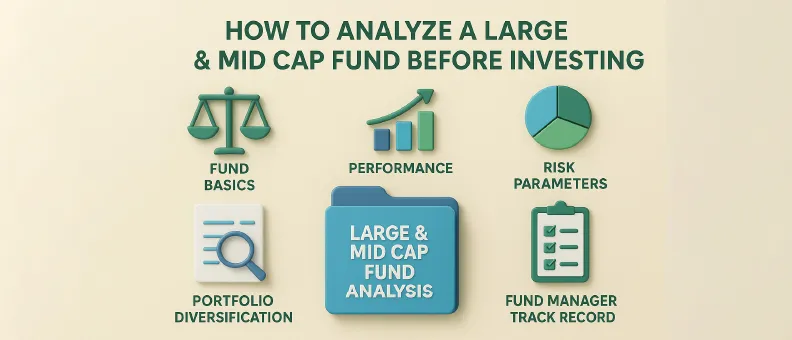How to Analyse a Large and Mid Cap Fund Before Investing


Large and mid cap mutual funds occupy a distinctive niche in India’s equity landscape. They blend the relative earnings stability of blue chip giants with the expansion potential of fast growing mid-sized businesses. For investors who want blended equity exposure without running two separate schemes, a single large and mid-cap fund can streamline asset allocation and paperwork. Yet, because these portfolios straddle two very different market segments, evaluating them demands a wider lens than analysing a pure play large cap or mid cap strategy.
One may ask then, how to analyse a large and mid cap fund? It is essential to weigh regulatory mandates, potential cost drags, risk metrics and the fund manager’s skill––ideally through a disciplined, data driven checklist, before considering to commit any capital.
- Table of contents
- Key parameters to analyse before investing
- Evaluating past performance of the fund
- Understanding the risk profile of the fund
- Role of fund manager and management style
- Asset allocation and diversification check
- Tools and platforms to analyse mutual funds
- Common mistakes to avoid while investing
Key parameters to analyse before investing
| Parameter | Why it matters |
|---|---|
| Regulatory mandate | SEBI defines large caps as ranks 1 to 100 and mid caps as 101 to 250 by full market capitalisation. A large and mid-cap scheme must keep at least 35% in each bucket at all times |
| Expense ratio | Ongoing cost deducted daily from NAV. |
| Exit load | Early redemption fee affects liquidity plans. Many funds levy 1% if units are sold within 15 days |
| Riskometer label | SEBI’s pictorial gauge now spans six bands from “Low” to “Very High” |
Evaluating past performance of the fund
Investors can do past fund performance evaluation via:
- Rolling return comparison: Plot 3, 5 and 7 year rolling windows versus this benchmark. A fund beating the index in at least half of the observations may indicate useful consistency.
- Peer group quartile rank: A lot of reliable screeners display category standings; funds that remain in the top two quartiles across periods illustrate repeatability.
Read Also: Difference Between Large Cap, Mid Cap, and Small Cap Funds
Understanding the risk profile of the fund
Risk analysis of large and mid cap funds centres on volatility:
- Standard deviation and beta – Compare to the Nifty LargeMidcap 250 TRI. Values comfortably below 1 beta imply volatility similar to or lower than the index.
- Maximum drawdown – Review how deeply the fund fell in the 2020 and 2022 corrections; quicker recoveries hint at prudent stock selection.
- Riskometer check – Funds in this category usually fall under “High” or “Very High”; assess whether that lines up with your tolerance.
Role of fund manager and management style
- Tenure and track record – Longer stewardship across market cycles may help you separate skill from luck.
- Investment approach – Factsheets often clarify whether the portfolio is growth tilted, value oriented, or a blended style. Match this with your own return expectations and temperament.
- Succession depth – An analyst bench or named co-manager reduces single person dependency, an often overlooked part of diligence.
Read Also: Retirement Planning with Large Cap & Mid Cap Fund
Asset allocation and diversification check
- Regulatory compliance – Confirm the portfolio keeps ≥ 35% each in large and mid caps; temporary drifts must be corrected within SEBI’s rebalancing window.
- Sector spread – Look for exposure caps to avoid cyclical concentration.
- Stock level limits – A single holding rarely exceeds 8 to 10% in this category; higher weights may add idiosyncratic risk.
- Rebalancing rhythm – Check whether the fund follows a quarterly or semi-annual rebalance when market moves distort weights.
Tools and platforms to analyse mutual funds
- AMFI portal – Official scheme documents, monthly holdings, Riskometer colour band, and TER disclosures direct from asset managers.
- SEBI website – Circulars such as the 06 Oct 2017 categorisation directive (your anchor for regulatory rules)
- Reliable category screeners – Rolling return charts, category averages, exit load flags and risk metrics - convenient for hands on mutual fund investment tips.
- News on mutual funds – Timely articles on policy tweaks, tax angles and performance studies.
- Direct AMC factsheets and mobile apps – Real time NAVs, commentary, and downloadable portfolios for deeper analysis.
Spend time familiarising yourself with at least two of these resources; it can potentially speed up future fund performance evaluation.
Common mistakes to avoid while investing
- Chasing recent top quartile returns – Past data offers context, not certainty. Returns are not guaranteed and past performance may or may not be replicated in the future.
- Ignoring cost drag – Category average TER nearly touches 1.9%; picking a relatively cheaper plan can potentially improve long run outcomes (link).
- Mis-sizing risk – Large and mid cap funds can correct as sharply as dedicated mid cap funds. Factor this into asset allocation.
- Over-diversifying – Holding four similar schemes dilutes conviction without reducing risk meaningfully.
- Skipping periodic reviews – Re-evaluate at least every six months; rebalance if the fund lags its benchmark consistently.
Conclusion
A credible analysis of large and mid cap mutual funds marries cost discipline, rigorous risk analysis and benchmark-aware performance review. By sticking to verified SEBI, AMFI and top tier business-daily data, and aligning each scheme’s profile with your objectives, you can raise the odds of a potentially rewarding long term investment experience.
FAQs:
What is a large and mid-cap mutual fund?
An open ended equity scheme that invests a minimum 35% each in large cap (rank 1 to 100) and mid-cap (rank 101 to 250) stocks.
How can I check the risk level of a mutual fund?
Refer to the SEBI-mandated Riskometer, which displays six risk tiers from Low to Very High on every factsheet.
Is past performance a reliable indicator for future returns?
It offers perspective but does not guarantee similar outcomes; focus more on rolling-return consistency and the fund’s investment process. Remember, past performance may or may not be replicated in the future.
How often may I review my mutual fund investment?
A semi-annual review aligns with AMFI’s stock-classification updates and helps you act on any prolonged under-performance without overreacting to short term noise.
Mutual Fund investments are subject to market risks, read all scheme related documents carefully.
This document should not be treated as endorsement of the views/opinions or as investment advice. This document should not be construed as a research report or a recommendation to buy or sell any security. This document is for information purpose only and should not be construed as a promise on minimum returns or safeguard of capital. This document alone is not sufficient and should not be used for the development or implementation of an investment strategy. The recipient should note and understand that the information provided above may not contain all the material aspects relevant for making an investment decision. Investors are advised to consult their own investment advisor before making any investment decision in light of their risk appetite, investment goals and horizon. This information is subject to change without any prior notice.
The content herein has been prepared on the basis of publicly available information believed to be reliable. However, Bajaj Finserv Asset Management Ltd. does not guarantee the accuracy of such information, assure its completeness or warrant such information will not be changed. The tax information (if any) in this article is based on prevailing laws at the time of publishing the article and is subject to change. Please consult a tax professional or refer to the latest regulations for up-to-date information.